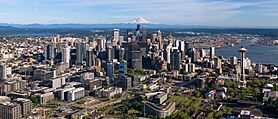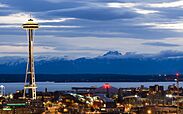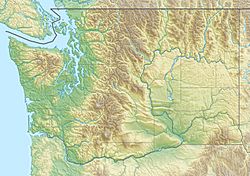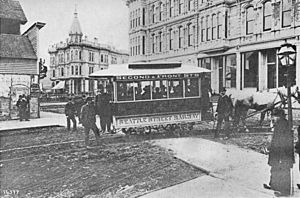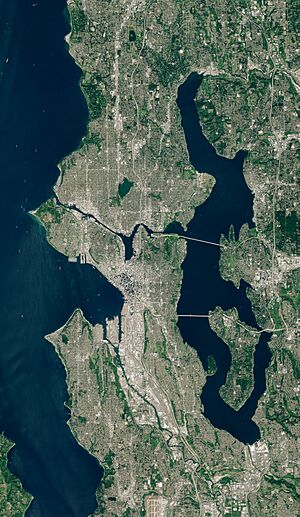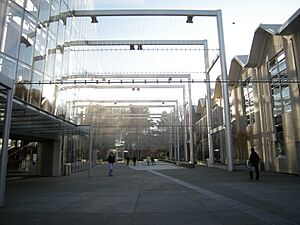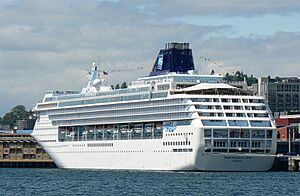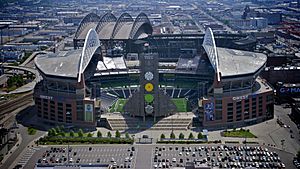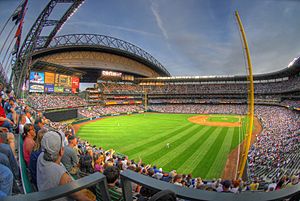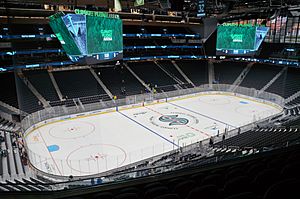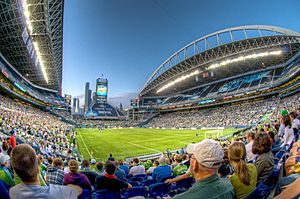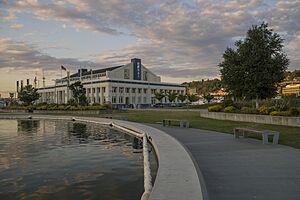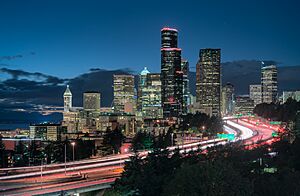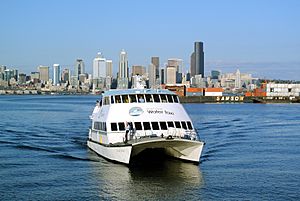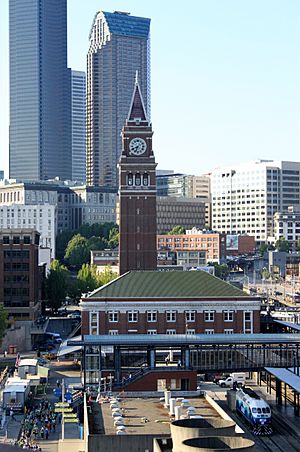Seattle facts for kids
Quick facts for kids
Seattle
dᶻidᶻəlal̕ič (Lushootseed)
|
|||||
|---|---|---|---|---|---|
|
|
|||||
|
|||||
| Nickname(s):
The Emerald City, Jet City, Rain City
|
|||||
| Motto(s):
The City of Flowers, The City of Goodwill
|
|||||
| Country | United States | ||||
| State | Washington | ||||
| County | King | ||||
| Founded | November 13, 1851 | ||||
| Incorporated as a town | January 14, 1865 | ||||
| Incorporated as a city | December 2, 1869 | ||||
| Named for | Chief Seattle | ||||
| Government | |||||
| • Type | Mayor–council | ||||
| • Body | Seattle City Council | ||||
| Area | |||||
| • City | 142.07 sq mi (367.97 km2) | ||||
| • Land | 83.99 sq mi (217.54 km2) | ||||
| • Water | 58.08 sq mi (150.43 km2) | ||||
| • Metro | 8,186 sq mi (21,202 km2) | ||||
| Elevation | 175 ft (53 m) | ||||
| Highest elevation | 520 ft (158 m) | ||||
| Lowest elevation | 0 ft (0 m) | ||||
| Population
(2020)
|
|||||
| • City | 737,015 | ||||
| • Estimate
(2023)
|
755,078 | ||||
| • Rank | 54th in North America 18th in the United States 1st in Washington |
||||
| • Density | 8,775.03/sq mi (3,387.95/km2) | ||||
| • Urban | 3,544,011 (US: 13th) | ||||
| • Urban density | 3,607.1/sq mi (1,392.7/km2) | ||||
| • Metro | 4,018,762 (US: 15th) | ||||
| Demonym(s) | Seattleite or Seattlite | ||||
| GDP | |||||
| • Metro | $517.803 billion (2022) | ||||
| Time zone | UTC−8 (PST) | ||||
| • Summer (DST) | UTC−7 (PDT) | ||||
| ZIP Codes |
ZIP Codes
|
||||
| Area code | 206 | ||||
| FIPS code | 53-63000 | ||||
| GNIS feature ID | 1512650 | ||||
|
|||||
Seattle (pronounced see-AT-uhl) is a major city on the West Coast of the United States. It is the largest city in Washington State and the Pacific Northwest. In 2023, about 755,078 people lived there. This makes Seattle the 18th most populated city in the U.S.
The city is located on a narrow strip of land. This land is between Puget Sound (part of the Pacific Ocean) and Lake Washington. Seattle is the northernmost big city in the U.S. It is about 100 miles (160 km) south of the Canadian border. The Port of Seattle is a very busy place for trade with East Asia. It is one of the largest ports in North America.
Native American people lived in the Seattle area for at least 4,000 years. The Duwamish people had many villages around Elliott Bay. European settlers arrived in 1851. They named the new settlement "Seattle" to honor Chief Seattle. He was an important leader of the local Duwamish and Suquamish tribes. Today, Seattle is known for its diverse population.
At first, logging was Seattle's main business. Later, it became a center for trade and shipbuilding. This was especially true during the Klondike Gold Rush. After World War II, the city grew a lot. This was partly because of Boeing, a company that made airplanes.
In the 1980s, Seattle became a hub for technology. Companies like Microsoft and Amazon started here. This led to a big economic boost. Many new people moved to the city.
Seattle also has a rich music history. In the past, it was famous for jazz clubs. Later, it became the birthplace of grunge music. Famous bands like Nirvana and Pearl Jam came from Seattle.
Contents
- History of Seattle
- Geography of Seattle
- People and Population in Seattle
- Economy of Seattle
- Culture and Arts in Seattle
- Sports in Seattle
- Parks and Outdoor Fun in Seattle
- Education in Seattle
- Media in Seattle
- Transportation in Seattle
- Utilities in Seattle
- International Relations
- Images for kids
- See also
History of Seattle
Archaeological excavations show that Native Americans lived in the Seattle area for at least 4,000 years. The Duwamish people had many villages around Elliott Bay. The name Seattle comes from a Duwamish village.
In 1792, George Vancouver was the first European to visit the area. He was exploring the Pacific Northwest for the British Navy.
Seattle in the 1800s

In 1851, a group of American pioneers arrived. They were led by Arthur A. Denny. They first landed at Alki Point on November 13, 1851. After a tough winter, most settlers moved across Elliott Bay. They called their new home Duwamps.
One of the founders, David Swinson "Doc" Maynard, suggested naming the town Seattle. This was to honor Chief Seattle, a leader of the Duwamish and Suquamish tribes. The name "Seattle" became official in 1853. The town became a city in 1869. It was also called the "Queen City." Later, in 1982, it became known as the "Emerald City."
Seattle has had many ups and downs in its economy. The first big boom was from the logging industry. The road now called Yesler Way was known as "Skid Road." This was because logs slid down the hill to a sawmill there.
In 1889, the Great Seattle Fire destroyed much of the downtown area. But the city quickly rebuilt. The Klondike Gold Rush in 1897 brought another big boom. Seattle became the main place for miners to get supplies for their journey to Alaska and the Yukon. Many businesses grew by selling clothes and food to these miners.
Seattle in the 1900s
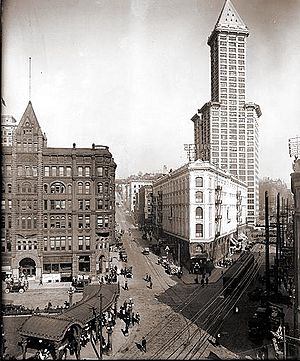
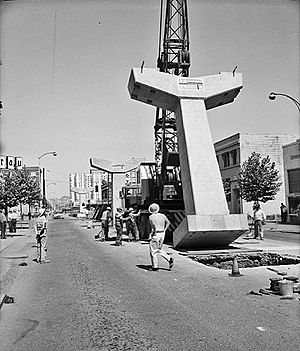
The Gold Rush helped many new companies start in Seattle. James E. Casey founded the American Messenger Company in 1907. This company later became UPS. Other famous companies like Nordstrom and Eddie Bauer also began here.
During World War I, shipbuilding became very important. This made Seattle a busy industrial city. After the war, there was a big workers' strike in 1919. Seattle faced hard times during the Great Depression in the 1930s. Many people lost their jobs.
World War II brought new jobs, especially at Boeing, which made aircraft. After the war, Boeing grew even more. Seattle showed off its growth at the 1962 World's Fair. The famous Space Needle was built for this event.
In the late 1960s and early 1970s, Boeing faced problems. Many people left Seattle to find work. But things changed in the 1980s. Microsoft moved its headquarters nearby. This started a new era of growth.
Seattle became a major center for technology. Companies like Amazon, F5 Networks, and Nintendo of America set up offices here. This led to a huge increase in population. Between 1990 and 2000, nearly 50,000 more people moved to Seattle.
The 1990s also saw grunge music become popular. Bands like Nirvana and Pearl Jam came from Seattle. The city gained more national attention from movies like Sleepless in Seattle.
Seattle in the 2000s
After a short economic slowdown in the early 2000s, Seattle boomed again. Amazon moved its main offices to South Lake Union. This caused a huge building spree. Many new apartments and buildings were constructed.
From 2010 to 2015, Seattle grew by about 14,500 residents each year. This growth made housing more expensive. Seattle has some of the highest living costs in the country. The city is working on ways to manage this growth.
Geography of Seattle
Seattle's Landscape and Waterways
Seattle is located between two large bodies of water. To the west is Puget Sound, which is an arm of the Pacific Ocean. To the east is Lake Washington. The city's main harbor, Elliott Bay, is part of Puget Sound. This makes Seattle an important port city.
Beyond Puget Sound to the west are the Olympic Mountains. To the east, beyond Lake Washington, are the Cascade Range mountains. Water from Lake Washington flows into Puget Sound through the Lake Washington Ship Canal. This canal includes smaller lakes like Lake Union.
The area around Seattle is perfect for outdoor activities. You can go sailing, skiing, biking, camping, and hiking all year.
Hills and Earthquakes in Seattle
Seattle is a hilly city. Like Rome, it is said to be built on seven hills. These often include Capitol Hill, First Hill, and Queen Anne. Many parts of the city center are quite hilly. Over time, some hills were reshaped to make building easier.
Seattle is in an earthquake zone because it is near the Pacific Ring of Fire. In 2001, a magnitude 6.8 earthquake caused damage. Other strong earthquakes have happened in the past. Scientists know that a very large earthquake could happen in the future.
The city covers about 142.5 square miles (368.9 km²). About 84 square miles (217.5 km²) is land, and 58.1 square miles (150.4 km²) is water.
Seattle's Climate and Weather
Seattle has a mild climate. Winters are cool and wet, and summers are mild and fairly dry. The nearby Puget Sound and Lake Washington help keep temperatures from getting too extreme. Very hot or very cold days are rare.
Seattle is known for its cloudy weather. It has many "rain days" each year. However, it often gets light drizzles rather than heavy downpours. So, Seattle actually receives less total rainfall than many other major U.S. cities.
People and Population in Seattle
Seattle's Diverse Population
Seattle has a diverse population. According to the 2016 American Community Survey, about 65.7% of people were White. About 16.9% were Asian, and 6.8% were Black or African American. About 6.6% were Hispanic or Latino.
Seattle's population has grown steadily. In 1960, most residents were white. By 2010, the percentage of white residents had decreased. Many people from different backgrounds have moved to Seattle.
The city has a large Chinese population. They come from mainland China, Hong Kong, and other parts of Asia. There are also many Vietnamese and Somali immigrants. Seattle also has one of the largest Cambodian and Samoan communities in the U.S.
In 2018, the average household income in Seattle was about $93,481. The city has a relatively high number of adults who live alone. In 2000, about 40.8% of households had only one person.
Economy of Seattle
Major Industries and Companies in Seattle
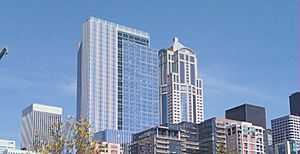

Seattle's economy is a mix of old and new industries. It has traditional companies and many new internet and technology businesses. Service, design, and clean energy companies are also important. In 2010, Seattle's economy was the 11th largest in the U.S.
The Port of Seattle is a key place for trade with Asia. It is also a major starting point for cruises to Alaska. It is the 8th largest port in the U.S. for handling containers.
Seattle is known for new businesses, especially in green building and clean energy. In 2010, the city aimed to become North America's first "climate neutral" city by 2030. This means trying to have zero greenhouse gas emissions.
Many large companies have their headquarters in Seattle. These include Amazon, Starbucks, Expeditors International of Washington, Nordstrom, Weyerhaeuser, Expedia Group, and Zillow. Other big companies like Costco and Microsoft are in nearby cities.
Seattle is famous for its coffee culture. Companies like Starbucks, Seattle's Best Coffee, and Tully's started here. There are also many small, independent coffee shops.
Boeing, a major airplane maker, used to have its headquarters in Seattle. While its main office moved, Boeing still has large factories in the area. It is the biggest private employer in the Seattle area.
Seattle is also a hub for global health. The Bill & Melinda Gates Foundation is based here. Many other organizations working on global health issues are also in Seattle.
Culture and Arts in Seattle
Performing Arts and Music Scene
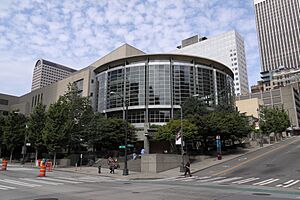
Seattle has a strong tradition in the performing arts. The Seattle Symphony Orchestra is over 100 years old and has won many awards. The Seattle Opera and Pacific Northwest Ballet are also very well-known. The Seattle Youth Symphony Orchestras is the largest youth symphony group in the U.S.
The 5th Avenue Theatre stages popular Broadway-style shows. Seattle has many theater companies and venues. It is a great place to see live plays.
Seattle has a rich music history. From 1918 to 1951, there were many jazz clubs. Famous musicians like Ray Charles and Quincy Jones started their careers here.
In the 1990s, Seattle became known for grunge music. Bands like Nirvana, Soundgarden, and Pearl Jam became famous worldwide. Other rock musicians like Jimi Hendrix also spent their early years in Seattle. Today, Seattle has many different types of music.
Fun Things to Do and See in Seattle
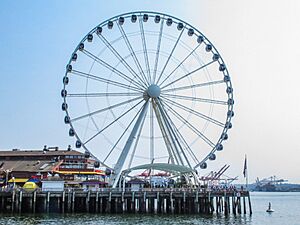
Seattle hosts many fun events and festivals each year. These include the Seattle International Film Festival and Northwest Folklife. Seafair events happen throughout July and August. They include boat races and cultural celebrations. The Bumbershoot festival celebrates music and art.
Other events include Native American pow-wows and various ethnic festivals. There are also specialized film festivals.
Seattle has several art museums. The Henry Art Gallery was the first public art museum in Washington. The Seattle Art Museum (SAM) has a downtown location and the Seattle Asian Art Museum. SAM also runs the Olympic Sculpture Park by the waterfront. The Frye Art Museum offers free admission.
For history, you can visit the Museum of History and Industry. The Museum of Flight focuses on airplanes and space. The National Nordic Museum and Wing Luke Asian Museum explore different cultures.
The Seattle Great Wheel is a large Ferris wheel on the waterfront. The Seattle Aquarium is also downtown. It has many marine animals and new exhibits.
The Woodland Park Zoo is a popular place to see animals. Seattle also has many community centers and parks. The Seattle Underground Tour explores old parts of the city that were buried after the Great Fire.
Seattle is a popular starting point for Alaska cruises. Many tourists visit the city before their cruise.
Sports in Seattle
Professional Sports Teams
Seattle has several major professional sports teams.
- The Seattle Seahawks play American football in the NFL. They won the Super Bowl in 2013. Their fans are known as the "12th Man" for being very loud.
- The Seattle Mariners play Baseball in MLB. They play at T-Mobile Park.
- The Seattle Kraken play Ice hockey in the NHL. They started playing in 2021 at Climate Pledge Arena.
- The Seattle Sounders FC play soccer in MLS. They have won the MLS Cup twice. They play at Lumen Field.
- The Seattle Storm play Basketball in the WNBA. They have won four WNBA championships.
- The Seattle Reign FC play soccer in the NWSL.
- The Seattle Seawolves play rugby in MLR. They have won two league championships.
Seattle's sports history goes back to 1917. The Seattle Metropolitans hockey team was the first American team to win the Stanley Cup.
Seattle has hosted the Major League Baseball All-Star Game three times. It will also be one of the host cities for the 2026 FIFA World Cup.
Parks and Outdoor Fun in Seattle
Seattle's mild climate allows for outdoor activities all year. You can enjoy walking, cycling, hiking, skiing, kayaking, and more. The city has 485 parks and green spaces. These cover about 6,500 acres (2,600 ha). This is about 12% of Seattle's land area.
The largest park is Discovery Park. It has forests and saltwater beaches. Popular parks include Green Lake with its walking trail. Alki Beach Park and Myrtle Edwards Park are near the waterfront. Volunteer Park and Seward Park are also very popular.
Many parks offer great views of the Seattle skyline. These include Kerry Park on Queen Anne Hill and Gas Works Park in Wallingford. Gas Works Park has old industrial structures that are now part of the park.
Seattle has many trails for biking and walking. The Burke–Gilman Trail is 27 miles (43 km) long. It follows the Ship Canal and Lake Washington. The Mountains to Sound Trail connects to the mountains. People also love to hike and ski in the nearby Cascade or Olympic Mountains.
Education in Seattle
Schools and Universities in Seattle
Seattle has a highly educated population. Over half of the adults in the city have a college degree. In 2008, Seattle had the highest percentage of college graduates among major U.S. cities.
Seattle Public Schools is the main school district. It serves most of the city's students. There are also many private schools, including Catholic and secular ones.
Seattle is home to the University of Washington. This is a large and well-known public university. It is ranked among the top universities in the world. The University of Washington receives a lot of funding for research.
Other smaller private universities in Seattle include Seattle University and Seattle Pacific University. The Seattle Colleges District has three community colleges. These are North Seattle College, Seattle Central College, and South Seattle College.
Media in Seattle
News and Entertainment in Seattle
Seattle has one main daily newspaper, The Seattle Times. The Seattle Post-Intelligencer used to be a daily paper. Now it is only published online. There are also weekly "alternative" papers like the Seattle Weekly and The Stranger.
Seattle has many TV and radio stations. You can find all the major U.S. networks. There are also many non-commercial radio stations. KEXP-FM is a well-known station that plays a variety of music.
Transportation in Seattle
Getting Around Seattle
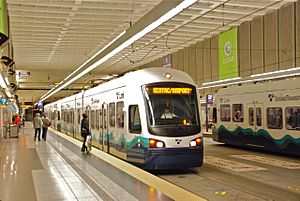
The first streetcars appeared in Seattle in 1889. They helped shape the city's layout. Over time, cars became more popular. Most streetcar lines were removed by 1941.
Today, King County Metro provides bus service throughout the city. Seattle is one of the few North American cities with electric trolleybuses. Sound Transit offers express bus service and commuter trains. It also runs the 1 Line light rail system. This light rail connects downtown to the airport and other areas.
Washington State Ferries connects Seattle to islands and other towns across Puget Sound. King Street Station in Pioneer Square is a hub for trains.
Many Seattle residents use public transportation. The city is also considered very walkable.
Seattle–Tacoma International Airport (Sea-Tac Airport) is south of the city. It offers flights to places all over the world. Boeing Field is closer to downtown. It is used for cargo and testing Boeing planes.
The main way to get around Seattle is by car. Major highways like Interstate 5 run through the city. From 1953 to 2019, State Route 99 ran on an elevated highway along the waterfront. This was replaced by a tunnel after earthquake damage. Seattle can have heavy traffic.
The city is working to improve public transit. Voters have approved plans to expand light rail. New light rail lines are opening to connect more parts of the region.
Utilities in Seattle
Water and electricity services are provided by the city. Seattle Public Utilities handles water. Seattle City Light provides electricity. About 90% of Seattle's electricity comes from hydropower. This is a clean energy source.
Seattle gets its drinking water from the Cedar River and Tolt River. These rivers are fed by melting snow in the Cascade Mountains. The city also manages wastewater and stormwater systems.
International Relations
Seattle has many sister cities around the world. These partnerships help build friendships and understanding between different cultures.
 Beersheba, Israel
Beersheba, Israel Bergen, Norway
Bergen, Norway Cebu City, Philippines
Cebu City, Philippines Chongqing, China
Chongqing, China Christchurch, New Zealand
Christchurch, New Zealand Daejeon, South Korea
Daejeon, South Korea Galway, Ireland
Galway, Ireland Gdynia, Poland
Gdynia, Poland Haiphong, Vietnam
Haiphong, Vietnam Kaohsiung, Taiwan
Kaohsiung, Taiwan Kobe, Japan
Kobe, Japan Limbe, Cameroon
Limbe, Cameroon Mombasa, Kenya
Mombasa, Kenya Nantes, France
Nantes, France Pécs, Hungary
Pécs, Hungary Perugia, Italy
Perugia, Italy Reykjavík, Iceland
Reykjavík, Iceland Sihanoukville, Cambodia
Sihanoukville, Cambodia Surabaya, Indonesia
Surabaya, Indonesia Tashkent, Uzbekistan
Tashkent, Uzbekistan
Images for kids
See also
 In Spanish: Seattle para niños
In Spanish: Seattle para niños


